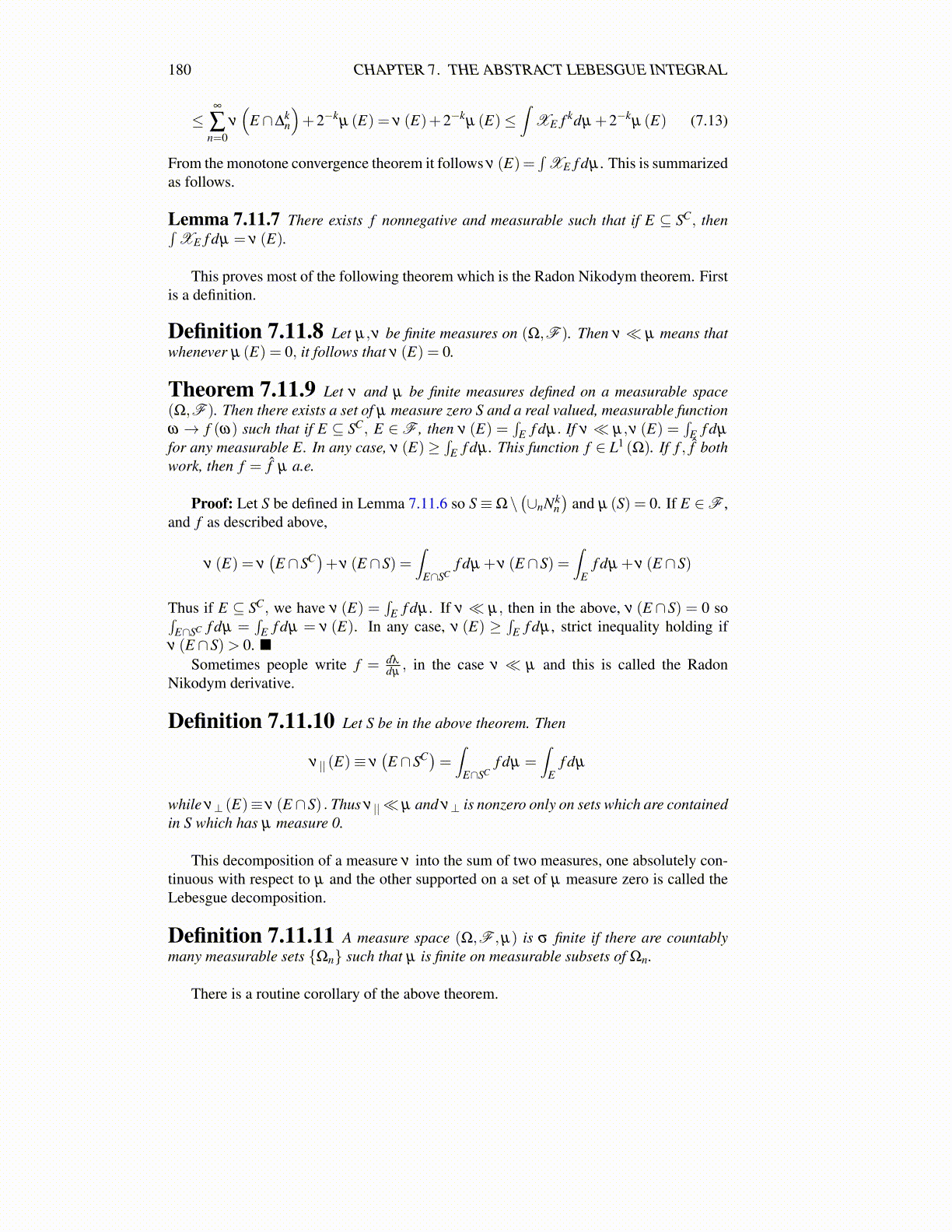
180 CHAPTER 7. THE ABSTRACT LEBESGUE INTEGRAL
≤∞
∑n=0
ν
(E ∩∆
kn
)+2−k
µ (E) = ν (E)+2−kµ (E)≤
∫XE f kdµ +2−k
µ (E) (7.13)
From the monotone convergence theorem it follows ν (E)=∫
XE f dµ . This is summarizedas follows.
Lemma 7.11.7 There exists f nonnegative and measurable such that if E ⊆ SC, then∫XE f dµ = ν (E).
This proves most of the following theorem which is the Radon Nikodym theorem. Firstis a definition.
Definition 7.11.8 Let µ,ν be finite measures on (Ω,F ). Then ν ≪ µ means thatwhenever µ (E) = 0, it follows that ν (E) = 0.
Theorem 7.11.9 Let ν and µ be finite measures defined on a measurable space(Ω,F ). Then there exists a set of µ measure zero S and a real valued, measurable functionω → f (ω) such that if E ⊆ SC, E ∈F , then ν (E) =
∫E f dµ. If ν ≪ µ,ν (E) =
∫E f dµ
for any measurable E. In any case, ν (E)≥∫
E f dµ . This function f ∈ L1 (Ω). If f , f̂ bothwork, then f = f̂ µ a.e.
Proof: Let S be defined in Lemma 7.11.6 so S≡Ω\(∪nNk
n)
and µ (S) = 0. If E ∈F ,and f as described above,
ν (E) = ν(E ∩SC)+ν (E ∩S) =
∫E∩SC
f dµ +ν (E ∩S) =∫
Ef dµ +ν (E ∩S)
Thus if E ⊆ SC, we have ν (E) =∫
E f dµ . If ν ≪ µ, then in the above, ν (E ∩S) = 0 so∫E∩SC f dµ =
∫E f dµ = ν (E). In any case, ν (E) ≥
∫E f dµ , strict inequality holding if
ν (E ∩S)> 0. ■Sometimes people write f = dλ
dµ, in the case ν ≪ µ and this is called the Radon
Nikodym derivative.
Definition 7.11.10 Let S be in the above theorem. Then
ν || (E)≡ ν(E ∩SC)= ∫
E∩SCf dµ =
∫E
f dµ
while ν⊥ (E)≡ ν (E ∩S) . Thus ν ||≪ µ and ν⊥ is nonzero only on sets which are containedin S which has µ measure 0.
This decomposition of a measure ν into the sum of two measures, one absolutely con-tinuous with respect to µ and the other supported on a set of µ measure zero is called theLebesgue decomposition.
Definition 7.11.11 A measure space (Ω,F ,µ) is σ finite if there are countablymany measurable sets {Ωn} such that µ is finite on measurable subsets of Ωn.
There is a routine corollary of the above theorem.